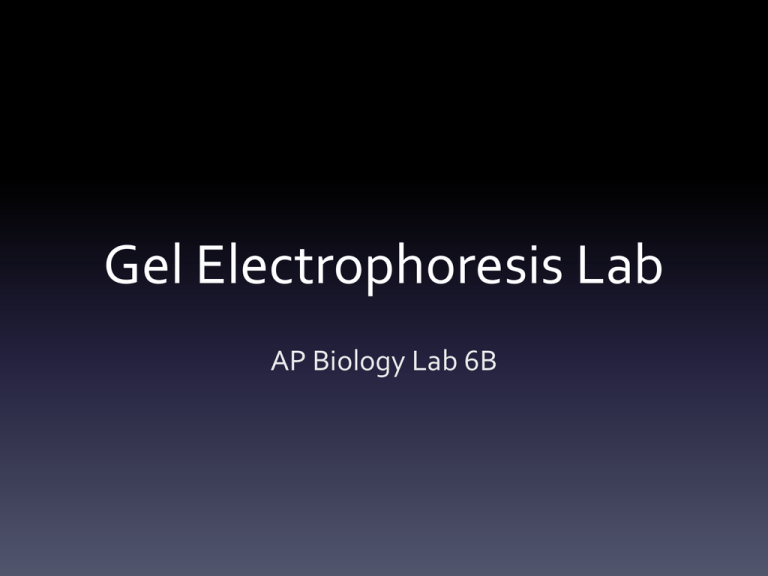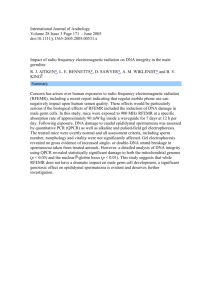Gel Electrophoresis Lab
advertisement

Gel Electrophoresis Lab AP Biology Lab 6B AP Bio Lab 6B Briefing • Problem: How can DNA fragments be separated and analyzed by gel electrophoresis? • Hypothesis: If DNA fragments of different sizes are separated through electrophoresis, then ___________________________ . AP Bio Lab 6B Briefing • Restriction enzymes (RE’s): recognize specific DNA sequences and cut DNA at these sites • RE’s in this lab: EcoRI and PstI – EcoRI: sequence GAATTC, cuts G | AATTC – PstI: sequence CTGCAG, cuts CTGCA | G • RFLP Analysis: uses RE’s to cut DNA so that a gel electrophoresis can be run to create a DNA fingerprint Restriction Enzyme EcoRI AP Bio Lab 6B Briefing • Standard Sample: Lambda DNA cut with HindIII – Sizes of HindIII Lambda DNA fragments are known – Used as a basis for comparison to determine sizes of unknown DNA fragments – Create standard curve by graphing known data on semi-log paper Standard HindIII Lambda DNA Sample Standard Curve (plot of distance migrated vs. DNA size (base pairs) Who stole Mr. Olsen’s laptop? The Crime: On Monday morning, Mr. Olsen went into his office and found his iPad missing from his desk. The thief got into the locked room by breaking a window. When Officer Malterud examined the crime scene, he found blood on a sharp edge of the broken glass. Who stole Mr. Olsen’s laptop? Your Job: Determine whose blood matches the evidence found at the crime scene through comparing the DNA of the crime scene with 5 suspects through the process of gel electrophoresis. Who stole Mr. Olsen’s laptop? The Suspects: 1. Mr. Arndt – upset because he was given goose poop-scooping duty in addition to walking 50 miles a day in the halls 2. Mr. Tank – asked Mr. Olsen for an iPad too for teaching AP Comp Sci, but was denied 3. Mr. Hoffmaster – reprimanded for stealing food from other teachers 4. Mr. Knaus – angry because he was told he had to teach dance fitness next semester 5. Mr. Moulton – because Mr. Olsen refused his request to raise the ceiling height in his room to 10’ in the building renovation Lab 6B Data Analysis 1. Using a ruler, measure the distance from the well to the center of each DNA band. Record it in the data table. 2. Using the data from the known HindIII lambda DNA, plot distance vs. size for Bands 2-6 on the semilog graph paper. Draw a best-fit line. This will be your standard graph. 3. Using the standard graph created in #2, determine the approximate size of each suspect or crime scene fragment. Fill in the data table. Lab Write-Up • For Part 6B, answer the Analysis and Questions on pgs. 75-77. • Write a separate Analysis and Conclusion for BOTH 6A and 6B of the lab. • For part 6B, discuss the results and explain how you know which suspect committed the crime.




